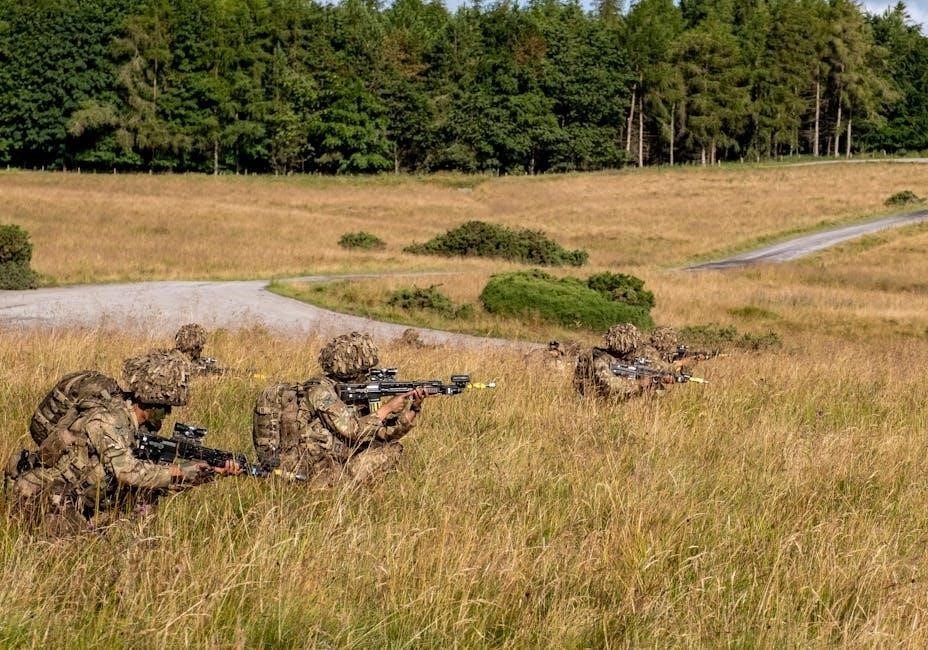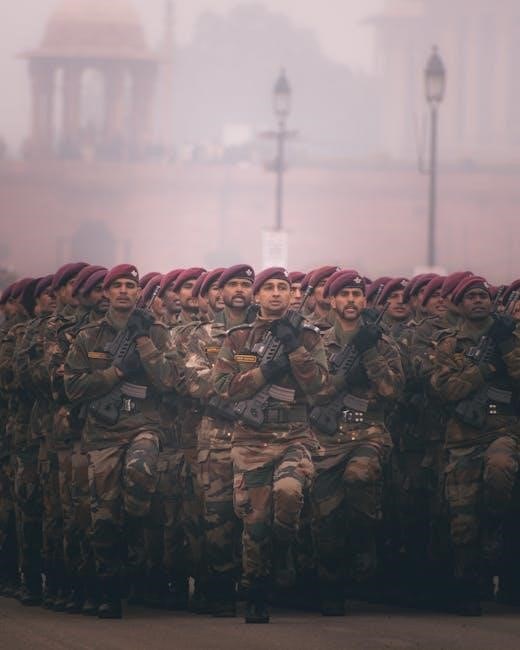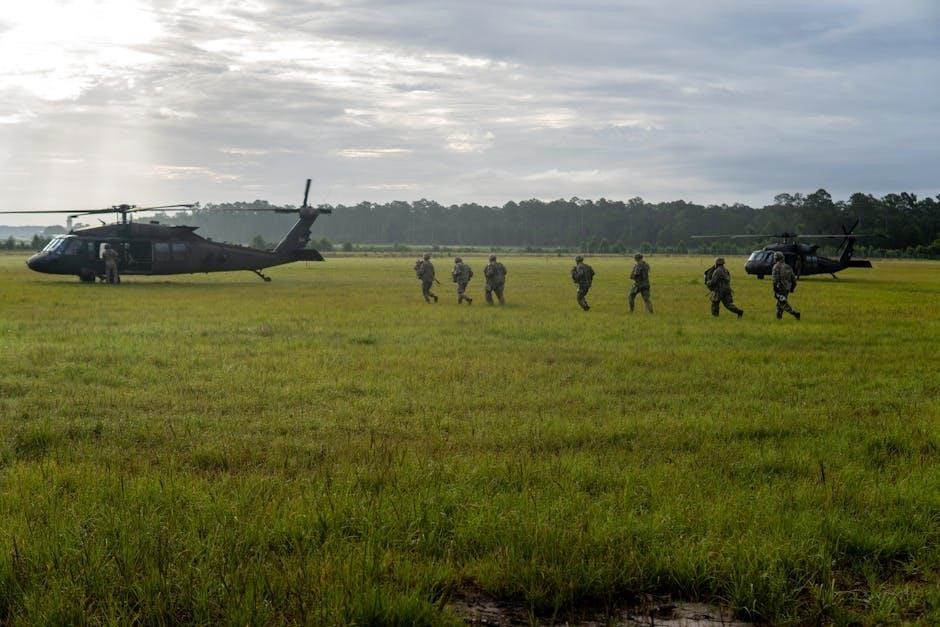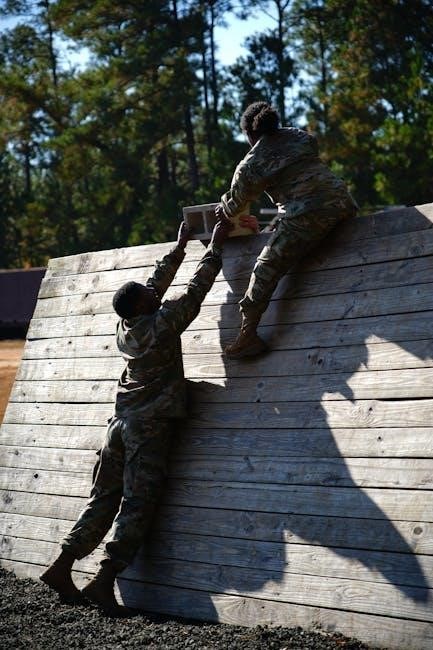
this is my squad army pdf
This Is My Squad (TIMS) is a leadership philosophy and communication platform fostering care, pride, and ownership within small Army units. Launched in 2019, it aims to enhance efficiency, readiness, and mentorship by empowering Soldiers to adapt best practices, aligning with the Army’s people-first approach.
1.1 Definition and Purpose
This Is My Squad (TIMS) is a leadership initiative launched in 2019 by Sergeant Major of the Army Michael A. Grinston. It emphasizes fostering a culture of care, pride, and ownership within small Army units. The purpose is to empower junior leaders, reduce harmful behaviors, and build cohesive teams, aligning with the Army’s people-first priorities and enhancing unit readiness and efficiency.
1.2 Importance of TIMS in Modern Army Context
This Is My Squad (TIMS) is vital for modern Army operations as it addresses critical challenges like harassment, assault, and unit cohesion. By fostering a culture of care and ownership, TIMS enhances readiness, reduces harmful behaviors, and strengthens leadership at the squad level, directly aligning with the Army’s people-centric priorities and improving overall mission effectiveness and soldier morale.

Background and History of TIMS
This Is My Squad (TIMS) was launched in August 2019 by Sergeant Major Michael A. Grinston, complementing General McConvilles people-first priority and fostering unit pride.
2.1 Launch and Initiation
This Is My Squad (TIMS) was officially launched in August 2019 by Sergeant Major of the Army Michael A; Grinston. The initiative aimed to foster a culture of care, pride, and ownership within small Army units, aligning with General James C. McConville’s people-first priority and emphasizing the importance of empowering junior leaders to drive positive change and improve unit cohesion.
2.2 Context Within Army Priorities
This Is My Squad (TIMS) aligns with the Army’s people-first approach, emphasizing unit pride and cohesive teams. It complements General James C. McConville’s priority on people, focusing on empowerment and ownership at the squad level. By fostering a culture of care and accountability, TIMS supports the Army’s broader goals of enhancing readiness and reducing harmful behaviors, ensuring squads are mission-effective and resilient.
Core Values and Principles
This Is My Squad (TIMS) emphasizes care, pride, and ownership, fostering a culture of empowerment and accountability to strengthen unit cohesion and mission effectiveness.
3.1 Care, Pride, and Ownership
Care, Pride, and Ownership are foundational to TIMS, fostering a culture where Soldiers prioritize their unit’s well-being, take responsibility for their actions, and strive for excellence in mission execution.
3.2 Empowerment of Junior Leaders
Empowerment of Junior Leaders is a cornerstone of TIMS, enabling junior NCOs to take ownership and lead effectively. By fostering a positive environment and providing mentorship, TIMS ensures junior leaders are equipped to address challenges, improve unit cohesion, and enhance overall readiness. This approach strengthens leadership at all levels, contributing to mission success and a more resilient Army.
Leadership and Communication Strategies
Leadership and communication strategies in TIMS focus on fostering effective communication and trust within squads. These approaches emphasize open dialogue, active listening, and collaboration to build cohesive teams and enhance mission accomplishment.
4.1 Techniques for Squad Leaders
Squad leaders employ techniques such as empowerment, ownership, and pride to foster a positive squad environment. They use open communication, active listening, and transparent dialogue to build trust and address challenges. Leaders also focus on shared goals, accountability, and continuous feedback to enhance team cohesion and mission success, aligning with TIMS principles of care and leadership.

4.2 Building Cohesive Teams
Building cohesive teams involves fostering unity and a shared identity among squad members. Leaders promote collaborative efforts and mutual respect, ensuring each member feels valued. By aligning actions with TIMS principles, teams develop trust and accountability, enabling them to work seamlessly together. This approach strengthens esprit de corps and enhances the squad’s ability to achieve mission success collectively.

Role of Squad Leaders
Squad leaders foster a positive environment, build cohesive teams, and ensure discipline. They mentor, lead by example, and take ownership of their squad’s actions and readiness.
5.1 Responsibilities in TIMS
Responsibilities include fostering a positive environment, building cohesive teams, and mentoring Soldiers. Squad leaders must lead by example, take ownership of their squad’s actions, and ensure discipline. They are expected to integrate Army Values and best practices into daily operations, enhancing unit readiness and effectiveness while addressing challenges promptly to maintain a culture of care, pride, and ownership within their squad.
5.2 Implementation Strategies
Implementation involves squad leaders conducting regular interactions with their teams to build trust and understanding. Leaders apply Army Doctrine Publication 6-22 principles, focusing on care, pride, and ownership. The Squad Leader Development Course (SLDC) provides tools to empower junior leaders, while continuous feedback and adaptation ensure alignment with unit goals, fostering a cohesive and disciplined squad environment.
Implementation Across the Army
This Is My Squad (TIMS) is implemented Army-wide, emphasizing small-unit leadership and care. It fosters a culture of ownership and pride, empowering junior leaders to drive unit cohesion and readiness across all echelons.
6.1 Impact on Different Echelons
This Is My Squad (TIMS) impacts all Army echelons by fostering a culture of care, pride, and ownership. It empowers junior leaders to build cohesive teams, enhancing readiness and efficiency. Higher echelons benefit from improved unit performance, while lower echelons experience strengthened leadership and reduced harmful behaviors, aligning with the Army’s people-first approach and modernization goals.
6.2 Feedback and Adaptations
This Is My Squad (TIMS) has received positive feedback for fostering unit cohesion and reducing harmful behaviors. Feedback highlighted improved leadership engagement and increased Soldier confidence. Adaptations include refining training materials and expanding resources to address emerging challenges, ensuring TIMS remains aligned with Army priorities and continues to evolve based on Soldier and leader input.
Impact on Unit Readiness and Efficiency
TIMS enhances unit readiness by fostering a culture of care, ownership, and cohesion, resulting in improved efficiency and reduced incidents of harassment and assault.
7.1 Measurable Outcomes
TIMS has led to a reduction in harassment, assault, and suicide incidents, fostering a more disciplined and positive environment. Units report improved mission accomplishment and readiness, with decreased disciplinary issues, highlighting the program’s success in enhancing cohesion and efficiency.
7.2 Success Stories and Case Examples
Units adopting TIMS have reported significant improvements, such as reduced harassment and assault incidents. The 224th Military Intelligence Battalion and Joint Base Lewis-McChord showcased enhanced cohesion and mission readiness. Soldiers expressed increased trust in leadership, highlighting TIMS’ role in fostering a positive, disciplined environment. These examples demonstrate the initiative’s effectiveness in improving unit culture and operational success.
Addressing Challenging Behaviors
TIMS fosters a culture of care and accountability, addressing harassment, assault, and toxic behaviors by empowering leaders to create positive, disciplined environments, reducing harmful incidents.
8.1 Reduction of Harassment and Assault
This Is My Squad (TIMS) aims to reduce harassment, assault, and other corrosive behaviors by fostering a culture of care, accountability, and respect. Leaders are empowered to identify and address harmful actions, promoting a positive environment. The initiative emphasizes zero tolerance for misconduct, encouraging Soldiers to take pride in their units and uphold Army values, thereby decreasing incidents and improving overall unit cohesion and safety.
8.2 Case Studies and Solutions
Case studies highlight TIMS’ effectiveness in addressing harmful behaviors. For example, a rifle squad reported reduced incidents of harassment after implementing TIMS principles. Solutions include fostering open communication, empowering junior leaders, and promoting a culture of accountability. These approaches have led to improved unit cohesion, reduced misconduct, and enhanced mission readiness, demonstrating TIMS’ positive impact on Army culture.

Training and Resources
The Army provides resources like the Squad Leader Development Course (SLDC) and handbooks to support TIMS. These materials help leaders build cohesive teams and address challenges effectively.
9.1 Squad Leader Development Course (SLDC)
The Squad Leader Development Course (SLDC) is a two-day program focusing on doctrine from Army Doctrine Publication 6-22 and research in human performance and organizational psychology. Leaders craft personal leadership philosophies, emphasizing commitment, trust, and developing others. The course includes guided discussions and practical exercises to enhance leadership skills and foster cohesive team environments, aligning with TIMS goals.
9.2 Available Materials and Tools
The TIMS initiative provides a comprehensive handbook and PDF resources, such as 21-14_1.pdf, offering practical solutions for tactical leaders. These materials complement Field Manual 3-21;8 and include tools to identify common challenges and implement effective strategies. Additional resources like annotated PDFs enhance study and application, ensuring leaders can build cohesive squads and address unit-specific issues efficiently.
Challenges and Criticisms
Challenges include resistance to cultural shifts and inconsistent implementation across units. Some critics argue the initiative overlaps with existing programs, potentially diluting its impact.
10.1 Obstacles Faced by Squad Leaders
Squad leaders face challenges such as resistance to cultural change, inconsistent implementation, and balancing mentorship with operational demands; Limited resources, varying levels of unit support, and the initiative’s overlap with existing programs can hinder progress. Additionally, leaders must navigate systemic barriers while fostering trust and addressing corrosive behaviors, requiring adaptive and resilient leadership strategies to ensure TIMS’ success.
10.2 Critiques and Controversies
This Is My Squad (TIMS) has faced criticism for its approach to addressing systemic issues like harassment and assault, with some arguing it lacks concrete enforcement mechanisms. Others question its effectiveness in fostering genuine cultural change, citing inconsistent implementation across units. Critics also highlight challenges in measuring outcomes and concerns that the initiative may be perceived as another top-down policy lacking grassroots engagement.

Case Studies and Success Stories
Case studies highlight units achieving improved cohesion and reduced incidents through TIMS, showcasing its impact on leadership and culture. Success stories demonstrate enhanced unit readiness.
11.1 Specific Examples of TIMS in Action
This Is My Squad (TIMS) has seen success in units where leaders fostered strong interpersonal connections, reducing incidents of harassment and assault. Squad leaders empowered to adapt best practices reported improved readiness and cohesion. For example, one unit implemented regular mentorship sessions, leading to a significant decrease in disciplinary issues. These examples demonstrate TIMS’ effectiveness in creating positive, mission-focused environments.
11.2 Lessons Learned and Best Practices
Lessons from TIMS highlight the importance of fostering strong relationships and open communication within squads. Best practices include empowering junior leaders, encouraging ownership, and addressing issues promptly. Units that embraced these strategies saw improved cohesion and mission readiness, underscoring TIMS’ effectiveness in creating a positive, resilient military culture focused on collective success.

Future of TIMS
The future of TIMS involves expanding its reach, integrating new strategies, and continuously improving to enhance unit readiness and foster a resilient military culture.
12.1 Plans for Expansion and Evolution
Plans for TIMS expansion focus on broadening its reach across the Total Army, integrating advanced training resources, and evolving to meet modern challenges. The initiative aims to enhance unit readiness and foster resilience by incorporating feedback from Soldiers. Future developments will emphasize adaptability, ensuring TIMS remains a cornerstone of Army leadership and culture for years to come.
12.2 Continuous Improvement Initiatives
Continuous improvement initiatives for TIMS involve integrating Soldier feedback to refine practices, enhancing leadership development programs, and updating training materials. Regular assessments ensure the initiative remains relevant and effective, fostering a culture of adaptability. Collaborative efforts across units and echelons further drive innovation, ensuring TIMS evolves to address emerging challenges and sustain its positive impact on Army culture and readiness.
This Is My Squad (TIMS) is a transformative leadership initiative empowering junior leaders to foster care, pride, and ownership. By reducing harmful behaviors and enhancing unit cohesion, TIMS has proven its value, setting a foundation for a more resilient and effective Army.
13.1 Summary of Key Points
This Is My Squad (TIMS) is a leadership initiative launched by Sergeant Major Michael A. Grinston in August 2019. It focuses on fostering care, pride, and ownership within small Army units. By empowering junior leaders, TIMS aims to reduce harmful behaviors, enhance unit cohesion, and improve readiness. Its success lies in creating a positive environment that strengthens Soldiers’ interpersonal connections and accountability, ultimately benefiting the entire Army.
13.2 Final Thoughts on TIMS Significance
This Is My Squad (TIMS) represents a transformative shift in Army culture, emphasizing empowerment and accountability at the squad level. By fostering a culture of care and ownership, TIMS addresses critical issues like harassment and assault, while enhancing unit cohesion and readiness. Its focus on junior leader development ensures sustainable growth, making TIMS a cornerstone of the Army’s commitment to its people and mission success.
Related Posts

acls exam version c answers pdf
Get ACLS Exam Version C answers in PDF format. Free study guide, practice questions, and instant download. Prepare smarter, not harder!

explaining adhd to a child pdf
Learn how to explain ADHD to children in a simple, engaging way. Download our free PDF guide to help kids understand and manage their ADHD.

john paul jackson books pdf free download
Access John Paul Jackson’s books for free in PDF. Instantly download his spiritual teachings and revelations.